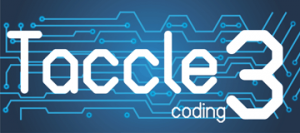 Although it is a stand alone and innovatory project, Taccle3 Coding will benefit from being part of the very successful ‘Taccle’ suite of projects, all of which have the common theme of providing resources, ideas, materials and staff training to support different aspects of the use of technology for learning. Taccle has, in several countries, become a ‘brand’ for creativity and innovation in using technology in the classroom and for delivering practical, fun and high quality workshops for professional development. Taccle is a quality kitemark for many teachers. We feel that by running this new project under the Taccle brand, we can capitalise on this previous success. Project dissemination can be speeded up using our existing website and teacher networks and exploitation of the project outputs is facilitated by being part of an identifiable brand which already has a range of linked products and a wide user-base.
Although it is a stand alone and innovatory project, Taccle3 Coding will benefit from being part of the very successful ‘Taccle’ suite of projects, all of which have the common theme of providing resources, ideas, materials and staff training to support different aspects of the use of technology for learning. Taccle has, in several countries, become a ‘brand’ for creativity and innovation in using technology in the classroom and for delivering practical, fun and high quality workshops for professional development. Taccle is a quality kitemark for many teachers. We feel that by running this new project under the Taccle brand, we can capitalise on this previous success. Project dissemination can be speeded up using our existing website and teacher networks and exploitation of the project outputs is facilitated by being part of an identifiable brand which already has a range of linked products and a wide user-base.
However, although we want to retain the key features, the quality criteria and the “packaging”, the content that will be developed is entirely different.
Taccle[1] developed teachers’ competences in producing digital content by developing learning objects and using Content Management Systems. Taccle2 focussed on giving teachers the skills and confidence to use web 2.0 tools and concentrated on children generating and publishing their own content. Taccle3 addresses a totally new subject area and looks at how teachers can help pupils learn to code . In summary, Taccle[1] was about teachers creating content, Taccle 2 was about learners using programs and apps to create their own content and Taccle3 Coding is about pupils creating the programs that generate the content.
There are several other innovatory features. Firstly, we have developed working partnerships with some of the world’s leading institutions in computer technology for learning. Notably these include MIT’s Lifelong Kindergarten , Wolfram Alpha’s Computer Based Maths project and the Mozilla Open Badge project. All of these organisations want to work with us on this Taccle Coding project as associates. Because they are US based, they cannot be part of the funded partnership. Similarly, we have talked to manufacturers such as Brio about working with us to produce Tangible User Interfaces by adapting their existing product range.
Secondly, the project will address the needs of teachers of younger children (from the time they start school up to 13/14 yrs old). Most primary teachers are generalist and primary schools do not usually have a computer science subject specialist. However, most of the existing resources for teaching computer programming are targeted at teachers assumed to have personal IT and subject skills already.
Thirdly, this project will look in detail at the ‘pre-programming’ phase in which young children can develop ‘computational thinking’, logic and syntax through fun activities, games and structured play. We will also look at how programming can be integrated across the curriculum with spin-off benefits for other subjects.
Fourthly it will look at the particular relevance of teaching programming as a way to create a positive mindset towards STEM with young children, especially with girls.
Fifthly, the project will not advocate one particular programming language but will reflect and explore the wide range of languages and devices that young programmers might use e.g Scratch, Logo, Turtle, Arduino and Raspberry Pi Python, Small Basic etc.
Sixthly, there will be a special emphasis on developing the entrepreneurial skills that are so often lacking in school computing course e.g licensing, taking products to market (how app stores work, preparing user guides, versioning, business models etc)
Finally, there will be an emphasis on keeping costs down, on making resources and upcycling other classroom equipment.
The demand for ICT professionals continues to grow. The European Commission estimates a shortfall of up to 900 000 ICT professionals in Europe by 2020. Of all job vacancies in ICT, computer programmers are the most in demand outnumbering the demand for other IT professionals by a factor of 5 to 1. The greatest demand is in UK, Germany, Estonia and other Northern European countries, which reflects the make up of the project partnership. In addition the OECD reports that more and more computer programmers prefer to be self-employed or working in micro-SME partnerships and not committed to one long-term employer and the vacancy market is beginning to reflect the increase in this new form of employment in the ICT sector.
Go here to the content-rich Taccle 3 Coding web portal: www.taccle3.eu
Project duration: 10/2015 - 09/2017
With the support of the EU Erasmus+ programme.
KA2 project “TACCLE 3 – Coding” (2015-1-BE02-KA201-012307)

